Air pollution is receiving more attention as a major environmental health threat, but one critical aspect is often overlooked: how it affects children in uniquely damaging ways, with devastating effects on their health and survival. Globally, 93% of children live in environments with air pollution levels above the World Health Organization’s (WHO) guidelines (WHO, 2018a). In 2016 almost 600,000 children under the age of 15 died from the joint effects of household and ambient (outdoor) air pollution (WHO, 2018b; in press).
WHO’s new publication Air Pollution and Child Health: Prescribing Clean Air summarises the latest evidence on the links between exposure to air pollution and adverse health effects in children. The report also highlights the necessary actions that international and national governments, communities and businesses across different sectors can take to reduce harmful exposures to air pollution (WHO, 2018a).
The links between air pollution and adverse health outcomes in children are becoming clearer. Studies have shown associations between exposure to ambient air pollution during pregnancy and adverse birth outcomes, including low birthweight, preterm birth, infants born small for gestational age and stillbirth. Research also suggests links between exposure to air pollution and infant mortality, impaired neurodevelopment, increased risk of childhood cancers (in particular leukaemia), exacerbation of childhood asthma and impeded lung growth and function.
There is compelling evidence that childhood exposure to air pollution is a significant risk in the development of respiratory infections, including pneumonia (Perera, 2017) and tuberculosis (Hwang et al., 2014). In 2016, the joint effects of household air pollution from cooking and ambient air pollution caused more than 50% of acute lower respiratory infections in children less than 5 years of age in low- and middle-income countries (WHO, 2018a).
Children who are exposed to air pollution are more likely to develop chronic illnesses later in life (Kassebaum et al., 2016). There is evidence that prenatal and childhood exposure to air pollution can predispose individuals to chronic lung and cardiovascular disease in adulthood. Poor lung growth and low peak lung function in early adulthood causes about half of all cases of chronic obstructive pulmonary disease (Sly and Bush, 2016).
All this evidence suggests that the best time to invest in a child’s health is the early years, starting in pregnancy. Precisely because children are one of the groups most vulnerable to environmental exposures, actions taken during this critical period can yield immense health benefits well into adulthood. Research suggests that actions taken to reduce childhood exposure to air pollution can reduce chronic illness later in life, decreasing the burden on public health systems and allowing individuals to participate fully in society.
Health professionals play an important role in reducing harmful childhood exposure to air pollution. As trusted sources of information, they are uniquely positioned to advocate solutions to other sectors and policymakers, and to educate colleagues and students about the dangers of air pollution. Robust and clear evidence is essential to inform local, national and international communities about the health effects of air pollution and to motivate action that can improve air quality.
Individual actions alone are not sufficient to reduce the global burden of air pollution. Approaches to preventing exposure must be complementary and mutually reinforcing: everyone, from individuals to health professionals, local and national governments, community leaders and the private sector, has a role in raising awareness of the adverse health effects of air pollution, reducing air pollution, and protecting the health of children now and in the future.
NOTE
This article was reviewed by Professor Peter D. Sly, WHO Collaborating Centre for Children’s Health and Environment, University of Queensland, Australia. The authors are staff members of the World Health Organization. The authors alone are responsible for the views expressed in this article and they do not necessarily represent the decisions, policy or views of the World Health Organization.
References can be found in the PDF version of the article.



